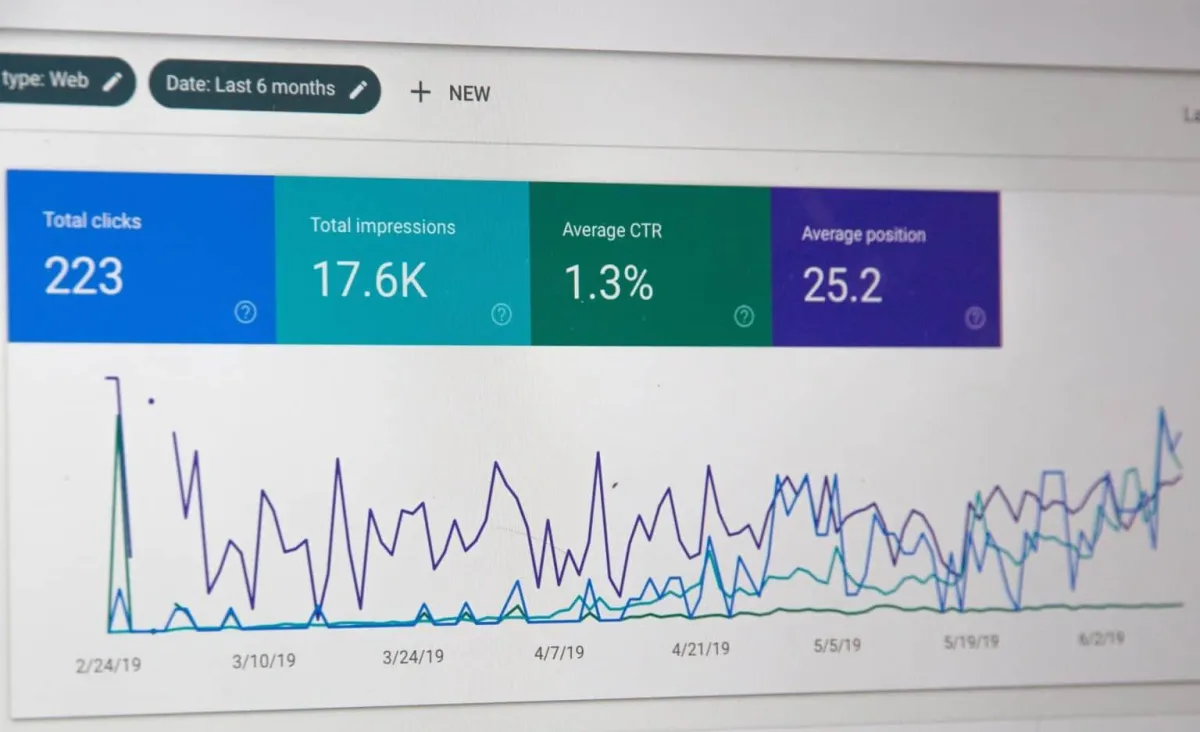TO LEARN IS TO GROW
Learning Center
We do our research and publish our results. Should probably call this the Growing Center.


Is Your Marketing Working? Proven Ways To Measure Performance
Is your marketing really making an impact? It’s a question every business owner asks, and figuring out the answer can be tough.
But don’t worry, we’ve got you covered! In this blog, we’ll explore how to track marketing performance for data-driven insights so you can make smarter decisions, grow faster, and get a better return on your investment (ROI).

Ready to take your marketing to new heights? Get started today by connecting with our team at LOJO Marketing. Together, we’ll ignite your strategies, leave competitors in the dust, and dominate your industry like never before.
Common Challenges in Measuring Marketing Performance
Measuring the success of marketing efforts can be daunting for businesses, so it’s no surprise that they face numerous challenges along the way.
Let’s explore some of the common hurdles encountered when gauging marketing performance:
Attribution
Understanding how marketing activities contribute to acquiring customers and driving conversions can be tricky, especially in campaigns that utilize multiple channels. Attribution, the process of assigning credit to specific marketing channels or campaigns, poses challenges in accurately linking outcomes to individual efforts. Additionally, the intricate nature of the customer journey adds further complexity to this task.
Data Overload
In the age of digital marketing, businesses are inundated with a wealth of data from various channels and tools, leaving businesses feeling overwhelmed and unsure of how to effectively collect, organize, and analyze it. Successfully harnessing the power of data requires dedicated resources and specialized expertise to handle the sheer volume of information.
Lack of Insightful Metrics
For businesses, finding the right metrics that truly shed light on marketing performance can be difficult. Simply relying on superficial metrics like social media followers or website traffic often falls short of capturing the real impact on business objectives. Overcoming this challenge requires a shift towards meaningful metrics that align with strategic goals, providing a deeper understanding of the effectiveness of marketing efforts.
Time and Resources
For small and medium-sized businesses, resource constraints can pose a significant challenge when it comes to tracking and measuring marketing performance. Limited availability of essential tools, lack of specialized skills, or inadequate personnel dedicated to comprehensive analysis can impede their ability to assess the impact of their marketing efforts effectively.
Why Tracking Key Metrics and Using Data-Driven Insights Is Important
In the realm of marketing, tracking key metrics and harnessing data-driven insights serve as the foundation for making informed decisions. Here’s why these practices are crucial for businesses aiming to stay ahead of the competition and drive remarkable success:
Performance Evaluation
Tracking key metrics allows you to assess the effectiveness of your marketing campaigns. By analyzing data, you can identify what’s working and what needs improvement, leading to more efficient allocation of resources.
Optimization Opportunities
Data-driven insights provide opportunities for optimization. By identifying areas of underperformance or high-performing strategies, you can make data-backed adjustments to your marketing tactics, maximizing your ROI.
Targeted Marketing
Understanding key metrics will help you gain insights into your target audience, enabling you to create more targeted and personalized marketing campaigns that resonate with them, resulting in better engagement and conversions.
Cost Efficiency
By tracking metrics and analyzing data, you’ll be able to identify areas where your marketing efforts are not generating the desired results. As a result, you can reallocate resources to more effective strategies, reducing wasteful spending and improving overall cost efficiency.
Competitive Advantage
Utilizing data-driven insights gives your businesses a competitive edge. By leveraging information about market trends, consumer behavior, and competitor strategies, you can take steps that differentiate you from competitors.
How To Tell if Your Marketing Is Working

1. Determine Your Marketing Goals and Objectives
Defining clear marketing goals and aligning them with your overall business objectives are crucial steps in measuring marketing performance. Clear-cut goals provide direction and serve as benchmarks for success. To focus resources effectively, your goals should be specific, measurable, attainable, relevant, and time-bound (SMART).
In addition, aligning marketing goals with business objectives ensures your marketing efforts contribute to the organization’s overall success. It creates synergy, prioritizes impactful initiatives, and fosters collaboration across departments.
Common marketing goals include:
increasing brand awareness
driving website traffic
boosting sales
enhancing customer retention
Tracking relevant metrics such as brand mentions, social media reach, conversion rates, or customer satisfaction scores helps evaluate the success of these goals.
By setting clear marketing goals, aligning them with overall business objectives, and tracking relevant metrics, you can effectively measure marketing effectiveness and make data-driven decisions to optimize your strategies.
2. Set Key Performance Indicators (KPIs)
Key Performance Indicators (KPIs) play a vital role in measuring marketing performance and tracking progress toward goals. They provide measurable values that directly reflect the success of your marketing efforts. Here’s why KPIs matter:
Evaluating Performance: KPIs allow you to assess how well you’re doing by comparing actual results to predefined targets. This evaluation helps you determine if you’re on track to achieve your marketing goals.
Data-Driven Decision-Making: KPIs provide valuable insights into what’s working and what needs adjustments or optimizations. By analyzing KPIs, you can make informed decisions, allocate resources effectively, and maximize your return on investment (ROI).
Tailored to Your Goals: The choice of KPIs depends on your specific marketing goals and objectives. Different types of KPIs can be used to measure different aspects of marketing effectiveness. Examples include:
Conversion rate measures the percentage of website visitors who take a desired action.
Click-through rate (CTR) measures engagement with marketing messages
Customer lifetime value (CLV) quantifies the long-term revenue potential of customers.
Social media engagement measures audience interaction.
Return ROI evaluates the financial impact of marketing efforts.
3. Use Tracking and Analytics Tools
To measure marketing performance and gain valuable insights, you can make use of various tracking and analytics tools. These tools provide data on different aspects of your marketing efforts and help assess their effectiveness. Here are some examples:
Google Analytics
A powerful web analytics tool that gives detailed information about website traffic, user behavior, conversions, and more.
Tracks metrics like website visits, pageviews, bounce rate, conversion rate, and revenue.
Advanced features like goal tracking, e-commerce tracking, and attribution modeling provide in-depth insights.
Social Media Analytics
Social media platforms such as Facebook, Instagram, Twitter, and LinkedIn offer their own analytics tools.
Provides data on audience demographics, engagement metrics, reach, and post performance.
Helps evaluate the effectiveness of social media marketing strategies.
Email Marketing Platforms
Email marketing platforms like Mailchimp, Constant Contact, or HubSpot provide analytics features for tracking email campaign performance.
Offers insights into open rates, click-through rates, conversion rates, and subscriber behavior.
Helps evaluate campaign effectiveness and optimize strategies.
Marketing Automation Platforms
Marketing automation platforms such as Marketo, Pardot, or HubSpot provide comprehensive tracking and analytics capabilities.
Tracks and measures the performance of various marketing channels and campaigns within a single system.
Provides insights on lead generation, customer behavior, campaign effectiveness, and ROI.
4. Implement Proper Tracking Mechanisms Across Different Marketing Channels
Implementing effective tracking mechanisms across marketing channels is essential for accurately measuring and evaluating performance. These mechanisms ensure data accuracy, providing a complete view of the customer journey and reliable data for analysis and decision-making.
Here’s why it matters:
Performance Comparison: Consistent tracking allows you to compare performance among different channels, which helps you optimize resource allocation and refine your marketing strategies.
Attribution Analysis: Tracking mechanisms enable you to understand the contribution of each channel to overall success. This attribution analysis provides valuable insights into channel effectiveness.
ROI Measurement: Tracking mechanisms attribute revenue or conversions to specific channels. This enables you to assess the effectiveness and profitability of each channel.
Data-Driven Decision-Making: Tracking mechanisms provide reliable data for budget allocation, campaign adjustments, targeting strategies, and overall marketing strategy. This supports data-driven decision-making and ensures your strategies are based on accurate information.
5. Perform A/B Testing and Experimentation
A/B testing, also known as split testing, is a valuable technique in digital marketing that compares different versions of marketing assets. It helps measure marketing effectiveness and provides insights for data-driven decision-making. Here’s why you should be doing it:
Empirical Decision-Making: A/B testing allows you to make informed choices based on real evidence. By comparing different variations, you can identify the most effective strategies for achieving marketing goals.
Continuous Improvement: A/B testing helps you continuously improve your marketing efforts. By testing and optimizing elements like headlines, calls-to-action, layouts, or images, you can refine your strategies based on feedback from your target audience.
Data-Based Decisions: A/B testing relies on concrete data, mitigating assumptions and biases. It enables you to make decisions based on actual user preferences and behaviors rather than guesswork.
6. Analyze and Interpret Data
Analyzing and interpreting marketing data is a vital part of measuring marketing performance. Here’s a simplified breakdown of the process:
Data Collection and Cleaning: Collect relevant marketing data and ensure its accuracy and quality.
Data Exploration and Analysis: Explore the data to uncover patterns, trends, and insights. Analyze your findings using appropriate techniques and tools.
Extracting Insights and Recommendations: Pick out valuable insights from the data and interpret their implications. Use these insights to make actionable recommendations.
Benchmarking and Evaluation: Compare your data against benchmarks or industry standards. Evaluate your performance, identify strengths and weaknesses, and conduct a competitive analysis.
Context and Relevance: Consider the specific objectives and context of your business and industry. Select metrics that are relevant to your goals and align with your business needs.
Effective Data Visualization: Visualize the data in a way that is clear and easy to understand. Use charts, graphs, or other visual representations to communicate insights effectively.
Expertise and Validation: Seek expertise if needed to ensure accurate interpretation of the data. Validate your findings and ensure they are reliable.
Documentation and Sharing: Document your insights and recommendations for future reference. Share the findings with relevant stakeholders to drive informed decision-making.
Continuous Improvement: Continuously iterate and improve your data analysis process. Refine your approach based on feedback and new insights.
Partner with a Digital Marketing Agency to Improve Your Marketing Efforts
Measuring and improving marketing effectiveness is vital for achieving business goals and driving success. By following the practices discussed in this blog on ways to measure marketing performance, you can make informed decisions and continuously enhance your marketing efforts.
As the digital marketing landscape constantly evolves, it’s essential that you stay updated with industry trends, actively seek improvement opportunities, and leverage the right tools. However, navigating the complexities of digital marketing may require expertise and dedicated resources.
Partnering with a digital marketing agency offers a competitive edge by providing access to professionals with specialized knowledge, tools, and resources. These experts can analyze your data, identify optimization opportunities, and provide strategic guidance to drive better results.
If you are in need of guidance or have any questions, schedule a FREE consultation with our team at LOJO Marketing today. Taking the proactive step of measuring and improving marketing effectiveness, along with seeking professional assistance, can help maximize your success in the digital marketplace.

Is Your Marketing Working? Proven Ways To Measure Performance
Is your marketing really making an impact? It’s a question every business owner asks, and figuring out the answer can be tough.
But don’t worry, we’ve got you covered! In this blog, we’ll explore how to track marketing performance for data-driven insights so you can make smarter decisions, grow faster, and get a better return on your investment (ROI).

Ready to take your marketing to new heights? Get started today by connecting with our team at LOJO Marketing. Together, we’ll ignite your strategies, leave competitors in the dust, and dominate your industry like never before.
Common Challenges in Measuring Marketing Performance
Measuring the success of marketing efforts can be daunting for businesses, so it’s no surprise that they face numerous challenges along the way.
Let’s explore some of the common hurdles encountered when gauging marketing performance:
Attribution
Understanding how marketing activities contribute to acquiring customers and driving conversions can be tricky, especially in campaigns that utilize multiple channels. Attribution, the process of assigning credit to specific marketing channels or campaigns, poses challenges in accurately linking outcomes to individual efforts. Additionally, the intricate nature of the customer journey adds further complexity to this task.
Data Overload
In the age of digital marketing, businesses are inundated with a wealth of data from various channels and tools, leaving businesses feeling overwhelmed and unsure of how to effectively collect, organize, and analyze it. Successfully harnessing the power of data requires dedicated resources and specialized expertise to handle the sheer volume of information.
Lack of Insightful Metrics
For businesses, finding the right metrics that truly shed light on marketing performance can be difficult. Simply relying on superficial metrics like social media followers or website traffic often falls short of capturing the real impact on business objectives. Overcoming this challenge requires a shift towards meaningful metrics that align with strategic goals, providing a deeper understanding of the effectiveness of marketing efforts.
Time and Resources
For small and medium-sized businesses, resource constraints can pose a significant challenge when it comes to tracking and measuring marketing performance. Limited availability of essential tools, lack of specialized skills, or inadequate personnel dedicated to comprehensive analysis can impede their ability to assess the impact of their marketing efforts effectively.
Why Tracking Key Metrics and Using Data-Driven Insights Is Important
In the realm of marketing, tracking key metrics and harnessing data-driven insights serve as the foundation for making informed decisions. Here’s why these practices are crucial for businesses aiming to stay ahead of the competition and drive remarkable success:
Performance Evaluation
Tracking key metrics allows you to assess the effectiveness of your marketing campaigns. By analyzing data, you can identify what’s working and what needs improvement, leading to more efficient allocation of resources.
Optimization Opportunities
Data-driven insights provide opportunities for optimization. By identifying areas of underperformance or high-performing strategies, you can make data-backed adjustments to your marketing tactics, maximizing your ROI.
Targeted Marketing
Understanding key metrics will help you gain insights into your target audience, enabling you to create more targeted and personalized marketing campaigns that resonate with them, resulting in better engagement and conversions.
Cost Efficiency
By tracking metrics and analyzing data, you’ll be able to identify areas where your marketing efforts are not generating the desired results. As a result, you can reallocate resources to more effective strategies, reducing wasteful spending and improving overall cost efficiency.
Competitive Advantage
Utilizing data-driven insights gives your businesses a competitive edge. By leveraging information about market trends, consumer behavior, and competitor strategies, you can take steps that differentiate you from competitors.
How To Tell if Your Marketing Is Working

1. Determine Your Marketing Goals and Objectives
Defining clear marketing goals and aligning them with your overall business objectives are crucial steps in measuring marketing performance. Clear-cut goals provide direction and serve as benchmarks for success. To focus resources effectively, your goals should be specific, measurable, attainable, relevant, and time-bound (SMART).
In addition, aligning marketing goals with business objectives ensures your marketing efforts contribute to the organization’s overall success. It creates synergy, prioritizes impactful initiatives, and fosters collaboration across departments.
Common marketing goals include:
increasing brand awareness
driving website traffic
boosting sales
enhancing customer retention
Tracking relevant metrics such as brand mentions, social media reach, conversion rates, or customer satisfaction scores helps evaluate the success of these goals.
By setting clear marketing goals, aligning them with overall business objectives, and tracking relevant metrics, you can effectively measure marketing effectiveness and make data-driven decisions to optimize your strategies.
2. Set Key Performance Indicators (KPIs)
Key Performance Indicators (KPIs) play a vital role in measuring marketing performance and tracking progress toward goals. They provide measurable values that directly reflect the success of your marketing efforts. Here’s why KPIs matter:
Evaluating Performance: KPIs allow you to assess how well you’re doing by comparing actual results to predefined targets. This evaluation helps you determine if you’re on track to achieve your marketing goals.
Data-Driven Decision-Making: KPIs provide valuable insights into what’s working and what needs adjustments or optimizations. By analyzing KPIs, you can make informed decisions, allocate resources effectively, and maximize your return on investment (ROI).
Tailored to Your Goals: The choice of KPIs depends on your specific marketing goals and objectives. Different types of KPIs can be used to measure different aspects of marketing effectiveness. Examples include:
Conversion rate measures the percentage of website visitors who take a desired action.
Click-through rate (CTR) measures engagement with marketing messages
Customer lifetime value (CLV) quantifies the long-term revenue potential of customers.
Social media engagement measures audience interaction.
Return ROI evaluates the financial impact of marketing efforts.
3. Use Tracking and Analytics Tools
To measure marketing performance and gain valuable insights, you can make use of various tracking and analytics tools. These tools provide data on different aspects of your marketing efforts and help assess their effectiveness. Here are some examples:
Google Analytics
A powerful web analytics tool that gives detailed information about website traffic, user behavior, conversions, and more.
Tracks metrics like website visits, pageviews, bounce rate, conversion rate, and revenue.
Advanced features like goal tracking, e-commerce tracking, and attribution modeling provide in-depth insights.
Social Media Analytics
Social media platforms such as Facebook, Instagram, Twitter, and LinkedIn offer their own analytics tools.
Provides data on audience demographics, engagement metrics, reach, and post performance.
Helps evaluate the effectiveness of social media marketing strategies.
Email Marketing Platforms
Email marketing platforms like Mailchimp, Constant Contact, or HubSpot provide analytics features for tracking email campaign performance.
Offers insights into open rates, click-through rates, conversion rates, and subscriber behavior.
Helps evaluate campaign effectiveness and optimize strategies.
Marketing Automation Platforms
Marketing automation platforms such as Marketo, Pardot, or HubSpot provide comprehensive tracking and analytics capabilities.
Tracks and measures the performance of various marketing channels and campaigns within a single system.
Provides insights on lead generation, customer behavior, campaign effectiveness, and ROI.
4. Implement Proper Tracking Mechanisms Across Different Marketing Channels
Implementing effective tracking mechanisms across marketing channels is essential for accurately measuring and evaluating performance. These mechanisms ensure data accuracy, providing a complete view of the customer journey and reliable data for analysis and decision-making.
Here’s why it matters:
Performance Comparison: Consistent tracking allows you to compare performance among different channels, which helps you optimize resource allocation and refine your marketing strategies.
Attribution Analysis: Tracking mechanisms enable you to understand the contribution of each channel to overall success. This attribution analysis provides valuable insights into channel effectiveness.
ROI Measurement: Tracking mechanisms attribute revenue or conversions to specific channels. This enables you to assess the effectiveness and profitability of each channel.
Data-Driven Decision-Making: Tracking mechanisms provide reliable data for budget allocation, campaign adjustments, targeting strategies, and overall marketing strategy. This supports data-driven decision-making and ensures your strategies are based on accurate information.
5. Perform A/B Testing and Experimentation
A/B testing, also known as split testing, is a valuable technique in digital marketing that compares different versions of marketing assets. It helps measure marketing effectiveness and provides insights for data-driven decision-making. Here’s why you should be doing it:
Empirical Decision-Making: A/B testing allows you to make informed choices based on real evidence. By comparing different variations, you can identify the most effective strategies for achieving marketing goals.
Continuous Improvement: A/B testing helps you continuously improve your marketing efforts. By testing and optimizing elements like headlines, calls-to-action, layouts, or images, you can refine your strategies based on feedback from your target audience.
Data-Based Decisions: A/B testing relies on concrete data, mitigating assumptions and biases. It enables you to make decisions based on actual user preferences and behaviors rather than guesswork.
6. Analyze and Interpret Data
Analyzing and interpreting marketing data is a vital part of measuring marketing performance. Here’s a simplified breakdown of the process:
Data Collection and Cleaning: Collect relevant marketing data and ensure its accuracy and quality.
Data Exploration and Analysis: Explore the data to uncover patterns, trends, and insights. Analyze your findings using appropriate techniques and tools.
Extracting Insights and Recommendations: Pick out valuable insights from the data and interpret their implications. Use these insights to make actionable recommendations.
Benchmarking and Evaluation: Compare your data against benchmarks or industry standards. Evaluate your performance, identify strengths and weaknesses, and conduct a competitive analysis.
Context and Relevance: Consider the specific objectives and context of your business and industry. Select metrics that are relevant to your goals and align with your business needs.
Effective Data Visualization: Visualize the data in a way that is clear and easy to understand. Use charts, graphs, or other visual representations to communicate insights effectively.
Expertise and Validation: Seek expertise if needed to ensure accurate interpretation of the data. Validate your findings and ensure they are reliable.
Documentation and Sharing: Document your insights and recommendations for future reference. Share the findings with relevant stakeholders to drive informed decision-making.
Continuous Improvement: Continuously iterate and improve your data analysis process. Refine your approach based on feedback and new insights.
Partner with a Digital Marketing Agency to Improve Your Marketing Efforts
Measuring and improving marketing effectiveness is vital for achieving business goals and driving success. By following the practices discussed in this blog on ways to measure marketing performance, you can make informed decisions and continuously enhance your marketing efforts.
As the digital marketing landscape constantly evolves, it’s essential that you stay updated with industry trends, actively seek improvement opportunities, and leverage the right tools. However, navigating the complexities of digital marketing may require expertise and dedicated resources.
Partnering with a digital marketing agency offers a competitive edge by providing access to professionals with specialized knowledge, tools, and resources. These experts can analyze your data, identify optimization opportunities, and provide strategic guidance to drive better results.
If you are in need of guidance or have any questions, schedule a FREE consultation with our team at LOJO Marketing today. Taking the proactive step of measuring and improving marketing effectiveness, along with seeking professional assistance, can help maximize your success in the digital marketplace.
Growing Businesses Since 2008
We have helped hundreds of businesses just like yours. Working for or along-side of business owner, managers, staff, or even board of directors, LOJO is ready to be an asset to your business.
Our team has been curated through the years for individual skills, personalities, and capabilities. Our clients put their trust in us to help them grow. We are here to do just that.



Growing Businesses Since 2008
We have helped hundreds of businesses just like yours. Working for or along-side of business owner, managers, staff, or even board of directors, LOJO is ready to be an asset to your business.
Our team has been curated through the years for individual skills, personalities, and capabilities. Our clients put their trust in us to help them grow. We are here to do just that.




Matthew Rogers, President
iProspect Check
After spending several months reviewing multiple proposals from several different companies we engaged LOJO to develop a new website that represents our company effectively. We worked initially with Stephen Platte who helped create the scope of the project. Stephen was knowledgeable and always followed up with me on time and as promised.
He "closed the deal" for LOJO with his professionalism, service orientation and easy going approach. Once we signed the contract we were introduced to Jay Kelly who would be the creative lead for LOJO. This was the most challenging part of the project for my company, as there was no shortage of ideas from our side. Jay managed the project flawlessly, and once we had all agreed to the design, Jay introduced us to Eric.
Eric Lay is one of the founders of LOJO. Eric took the design we had developed and brought it to life. We delivered content as quickly as he requested it. Eric kept the project on task and we responded by exceeding every deadline for content. In turn, once provided, literally not a day went by that Eric didn't add the content and take the next step. In just a few weeks we launched our new website. Eric is a pleasure to work with.
His positive attitude and consultative approach really enhanced the experience and made a big difference for us in the outcome of our project. We would welcome you to visit our website to take a look at the quality work of LOJO. We are very pleased with LOJO and look forward to working with them in the future as we pursue an aggressive SEO strategy."
After spending several months reviewing multiple proposals from several different companies we engaged LOJO to develop a new website that represents our company effectively. We worked initially with Stephen Platte who helped create the scope of the project. Stephen was knowledgeable and always followed up with me on time and as promised.
He "closed the deal" for LOJO with his professionalism, service orientation and easy going approach. Once we signed the contract we were introduced to Jay Kelly who would be the creative lead for LOJO. This was the most challenging part of the project for my company, as there was no shortage of ideas from our side. Jay managed the project flawlessly, and once we had all agreed to the design, Jay introduced us to Eric.
Eric Lay is one of the founders of LOJO. Eric took the design we had developed and brought it to life. We delivered content as quickly as he requested it. Eric kept the project on task and we responded by exceeding every deadline for content. In turn, once provided, literally not a day went by that Eric didn't add the content and take the next step. In just a few weeks we launched our new website. Eric is a pleasure to work with.
His positive attitude and consultative approach really enhanced the experience and made a big difference for us in the outcome of our project. We would welcome you to visit our website to take a look at the quality work of LOJO. We are very pleased with LOJO and look forward to working with them in the future as we pursue an aggressive SEO strategy."

Matthew Rogers, President
iProspect Check
The team at LOJO were wonderful to work with. They are well organized and very patient as we worked through our marketing strategy and developed a well thought out and clear action plan at a reasonable price. We will definitely be back for our future campaign needs."

Jon Crosby, Founder
Dazil

